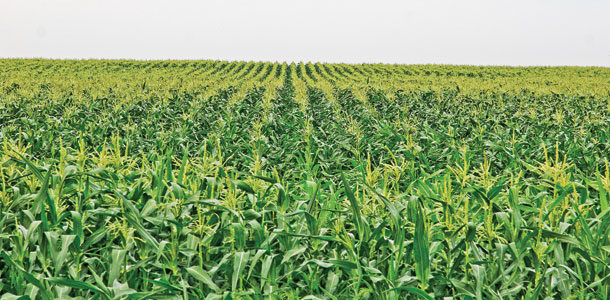The 2013 corn crop continues to limit milk production in many parts of the country, mainly because of its heavy bushel test weight. Reports of 60-pound bushel weights are commonplace this year. The starch content of this heavy test-weight corn is slow to ferment in the rumen, which lowers the amount of the volatile fatty acid (VFA) propionate produced as compared to a more typical corn starch year.
Of the VFAs, propionate is the main driver of milk production, and with lower propionate production, cows are not milking as well as they have in past growing seasons.
The other rumen byproduct of starch fermentation is lactic acid, which has a negative impact on rumen pH. With less lactic acid production, we are seeing less of a pH drop in the rumen, which favors the growth of fiber-digesting bacteria and increases fiber fermentation in the rumen.
When forage fiber (cellulose and hemicellulose) ferments, it primarily yields acetic acid, which is a driver for butterfat production. So on many herds producing 23,000 pounds and under, we are seeing less milk on the average but much higher butter fats.
Energy shortage in the corn
Higher-producing herds are running into energy issues. Unfortunately, propionate produces more energy in a ruminant animal than does acetate (more ATPs, a form of energy currency within cells, produced per unit of acid uptake).
With this shortage of energy from this year’s corn starch, high-producing cows can quickly become short on energy. They can make up this shortfall by eating more dry matter, producing less milk, losing more body condition or stealing energy from butterfat production.
Which one of these strategies a high-producing herd will follow varies with milk production level, dry matter intake, body condition and days pregnant.
As nutritionists, we can help influence which strategy the cows will follow by the ration and its contents. Today’s economics also play a key role in which path to follow as an extra pound of dry matter costs $0.13, loss of a pound of milk is $0.22, weight loss is calculated at $0.90 per pound and a loss of 0.1 percent butterfat at 80 pounds of milk is worth $0.16.
Reproduction also plays a key role in this economic hierarchy because we know that cows that lose more than one body condition score will have much poorer reproductive performance, and we make the loose assumption that a point of preg rate is worth $20 per cow per lactation on the average.
I see way too many dairy producers tossing in $0.25 per head per day of a fat product to try to recover a 0.1 percent of butterfat that is currently paying them $0.16 when reproduction is the best it has ever been. If the late-lactation cows are drying off at near perfect body condition, where is the payback?
A dairy producer’s first reaction may be to increase the amount of corn fed. Many have tried and quickly gotten themselves into trouble. Here is the issue: Corn starch that does not ferment in the rumen passes out of the rumen and is then available for small-intestine digestion and hindgut fermentation.
Starch is broken down to simple sugars in the intestine and plays a key role in providing energy to a ruminant. As nutritionists, we balance rations with this in mind and try to keep as little starch as possible from getting into the hindgut, where fermentation is very inefficient and excess fermentation can create gut heath issues.
The 2013 corn starch is not only poorly fermentable in the rumen, but it is also less digestible in the small intestine, allowing more corn starch into the hindgut, passing into the manure. A quick check of fecal starch will confirm this, as most farms are seeing at least twice the levels as previous years.
Adding more 2013 corn starch may just increase starch in the manure. When most dairy producers tried to add more dry shelled corn on the farm, they only saw more loose manure and no or even less milk.
Adjusting the ration
There are three solutions to this 2013 corn dilemma. Adding more rumen-fermentable starch to the diets by replacing 2 to 4 pounds of dried shelled corn starch with products like bakery, cereal, hominy, pure corn starch or any other ingredient that has a higher rumen starch fermentation rate will increase the starch fermented in the rumen and lower the amount of starch passing into the intestines.
Another approach is to add fat to make up for the decreased energy from the lack of propionate and adding bypass protein to make up for the lack of protein not being produced from the rumen bacteria.
Fermentable starch is a large driver for stimulating bacterial growth in the rumen, and with this slow-fermenting 2013 corn starch, it is limiting the microbial protein flow out of the rumen and into the small intestine, thereby shorting the cow on her protein requirements.
Feeding more bypass protein can offset some of this reduced microbial protein yield. While this is an expensive option with fat sources priced high and traditional bypass proteins at record-high prices (high-quality blood meal is over $2,000 per ton at writing), it can work to improve milk production.
The third option is to do nothing but wait until the starch in the corn silage and high-moisture grains finally starts to become more available to the cow. As I tell dairy producers, stick a brick in a solution with a pH of 4, and it will get soft over time.
The fermented feeds (corn silage and high-moisture grains) that have gone through a good fermentation will have a pH somewhere around 4. Given enough time, this 2013 corn starch will start to break down in the silage, and more of this starch will become available to the rumen bacteria for fermentation and the intestines for digestion.
This normally happens by the New Year, sometimes by Thanksgiving – and I have seen years where it did not happen until Easter; this looks like another Easter year.
I have seen few signs that the 2013 corn starch is getting better as of writing in mid-March. The lab tests of seven-hour starch digestion have not increased, soluble proteins are remaining steady and the ammonia fraction has remained fairly constant. All three numbers will start to increase when the starch fermentability improves.
Why soluble protein and ammonia? The starch molecules in the corn kernel sit in a protein casing very similar to how an egg sits in an egg carton. This casing is comprised of a protein called prolamin, which is not very soluble.
If soluble protein or ammonia start to increase, this means the protein casing is falling apart and the starch should fall out faster and be fermented quicker by the rumen bacteria. Some dairy producers have tried feeding or adding a digestive enzyme to their corn products this year, and some have had limited success.
The wetter and finer the corn starch is, the better the chances an enzyme will make contact and work. Treating dry, poorly processed corn silage typically yields poorer results as the enzymes will have a hard time reaching their intended target. Keep in mind, dry shelled corn will not improve in rumen fermentation unless it is ground finer. Age will not improve its feeding.
Another issue with the 2013 corn crop is its low protein content. I have seen many corn grain samples coming back from the lab at 6 to 7.5 percent crude protein (book values are around 9.5 percent). I think the extremely wet weather washed some of our nitrogen (N) out of the soil so there was less N uptake by the plant.
Many producers saw record tonnages or bushel yield in 2013, so we spread this reduced N over more units, further diluting it. Make sure your nutritionist has adjusted the protein content in your diets. Depending on how your corn tests and how much is in the ration, it may take up to half a pound of soybean meal to make up the difference.
The 2013 harvest has added several wrinkles to today’s feeding programs. The lack of starch fermentation and digestion has challenged nutritionists to get milk out of cows this year. Sound economic decisions have to come into play when considering options to improve the nutritional status of high-producing cows.
Timely sampling will show when the corn starts to improve by watching seven-hour starch digestion, soluble protein and ammonia levels. Testing will also show how low your protein is on this unforgettable 2013 corn. PD
Photo by PD staff.

Steve Massie
Western Field Nutritionist
Renaissance Nutrition Inc.






